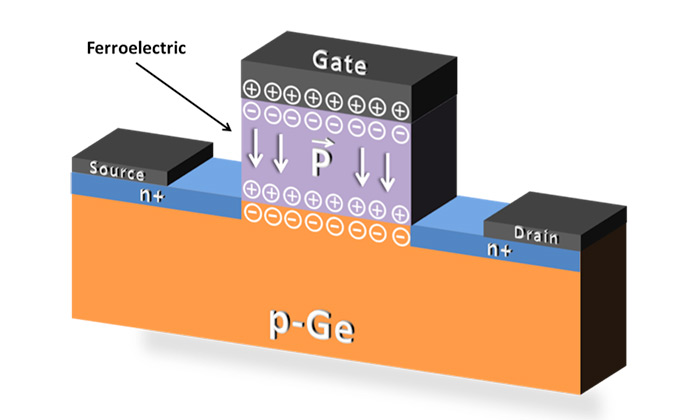Have you ever been working on a document on your computer and it suddenly crashes? Maybe the power goes out or there's a software glitch that causes it to freeze and you lose everything you've been working on for the past hour. New research published today in the journal Nature Communications might eventually lead to computers and other electronic devices that don't have this vulnerability.
 Computers have two basic ways of storing information: RAM, which can be written and read quickly, but is volatile (meaning when the power is off, the information is lost) and disc storage, which is slow to read and write, but is non-volatile. Your computer's working memory has to be fast to process your typing or your Skype call in real time. But you pay a price in vulnerability to power loss. For more than 20 years, scientists and engineers have sought to build a new type of electronic component, called a ferroelectric field effect transistor (FeFET), with the best properties of each type of data storage: quickly accessible and non-volatile.
Computers have two basic ways of storing information: RAM, which can be written and read quickly, but is volatile (meaning when the power is off, the information is lost) and disc storage, which is slow to read and write, but is non-volatile. Your computer's working memory has to be fast to process your typing or your Skype call in real time. But you pay a price in vulnerability to power loss. For more than 20 years, scientists and engineers have sought to build a new type of electronic component, called a ferroelectric field effect transistor (FeFET), with the best properties of each type of data storage: quickly accessible and non-volatile.
In the News
Gate built for Ferroelectric FET, Electronics Weekly
FeFET to Extend Moore's Law, EE Times
Physicists at The University of Texas at Austin, Oak Ridge National Laboratory and Arizona State University have taken a big step closer to building a FeFET by creating one of its three components, called a gate. The gate is the part that is either open or closed, corresponding to the 0s and 1s in a computer's binary language. Unlike a gate in the kinds of transistors currently used in RAM, this gate retains its state even when no power is applied.
Computers and other electronic devices with memories built on FeFETs would not only be less vulnerable to power loss, they would no longer take a minute or two to boot up when you turn them on. They would be instantly ready for work. Other possible applications include ultrahigh density memory, photovoltaic cells and reconfigurable logic, in which an entire circuit can be reprogrammed for a different function without changing the hardware.
The researchers used a technology called molecular beam epitaxy, which involves heating up elements inside a vacuum chamber so that they condense onto a surface, to grow a layer of barium titanate on a block of germanium. Barium titanate is ferroelectric, meaning that when it experiences an electric field, its atoms become orientated in a particular direction. In this case, the orientation of its atoms can be either up or down, a property that would make it useful for building transistor gates.
"This is the first time anyone has shown the ferroelectric field effect in a solid state device," says Alexander Demkov, physics professor and researcher at the Institute for Computational Engineering and Sciences at UT Austin and co-author of the paper.
Before they built the structure, the team developed a computer model that ran on the supercomputers at the Texas Advanced Computing Center to guide them in designing a crystal structure with the properties they wanted.
Patrick Ponath, a PhD candidate at UT Austin and first author of the paper, developed the technique for creating the new, layered structure.
What Ponath, Demkov and their colleagues have created is a two-dimensional layered structure. To be useful, they need to create an actual transistor with three-dimensional structure and not just a gate, but the other two components: a source and a drain. That will be a much more difficult engineering feat. So, for now, the race to build a true FeFET continues.
More information: Carrier density modulation in a germanium heterostructure by ferroelectric switching, Nature Communications, DOI: 10.1038/ncomms7067 .

















Comments